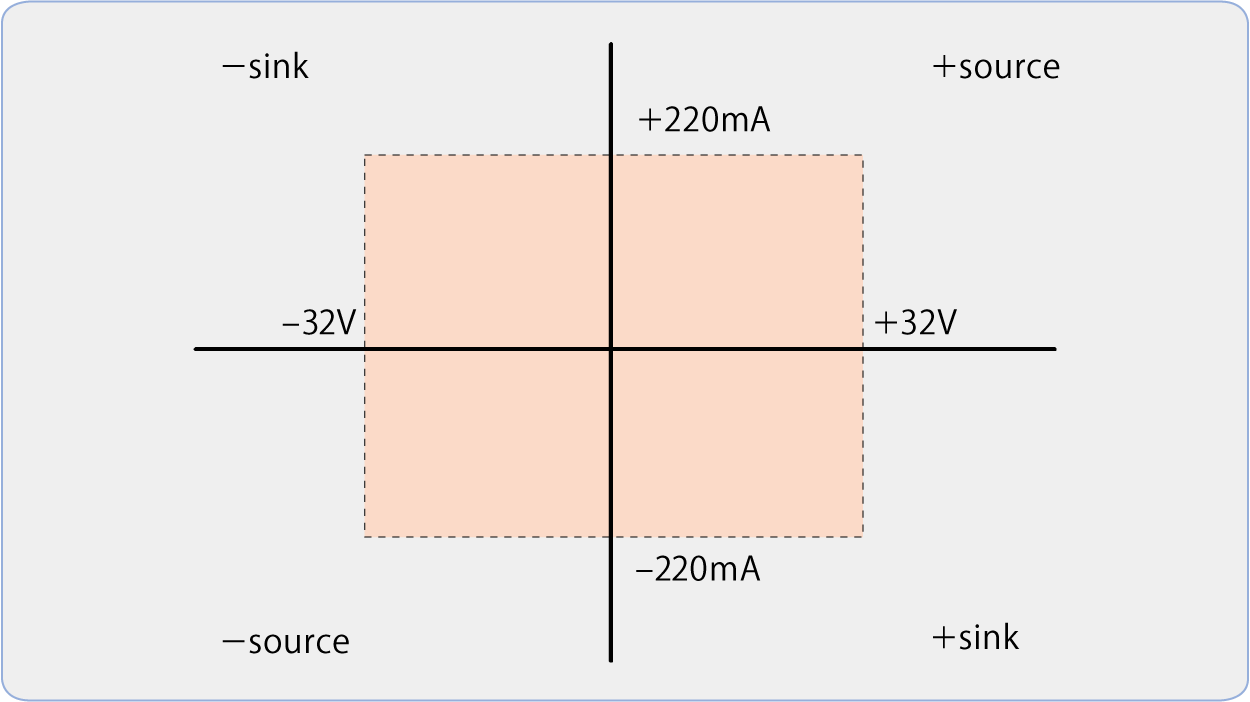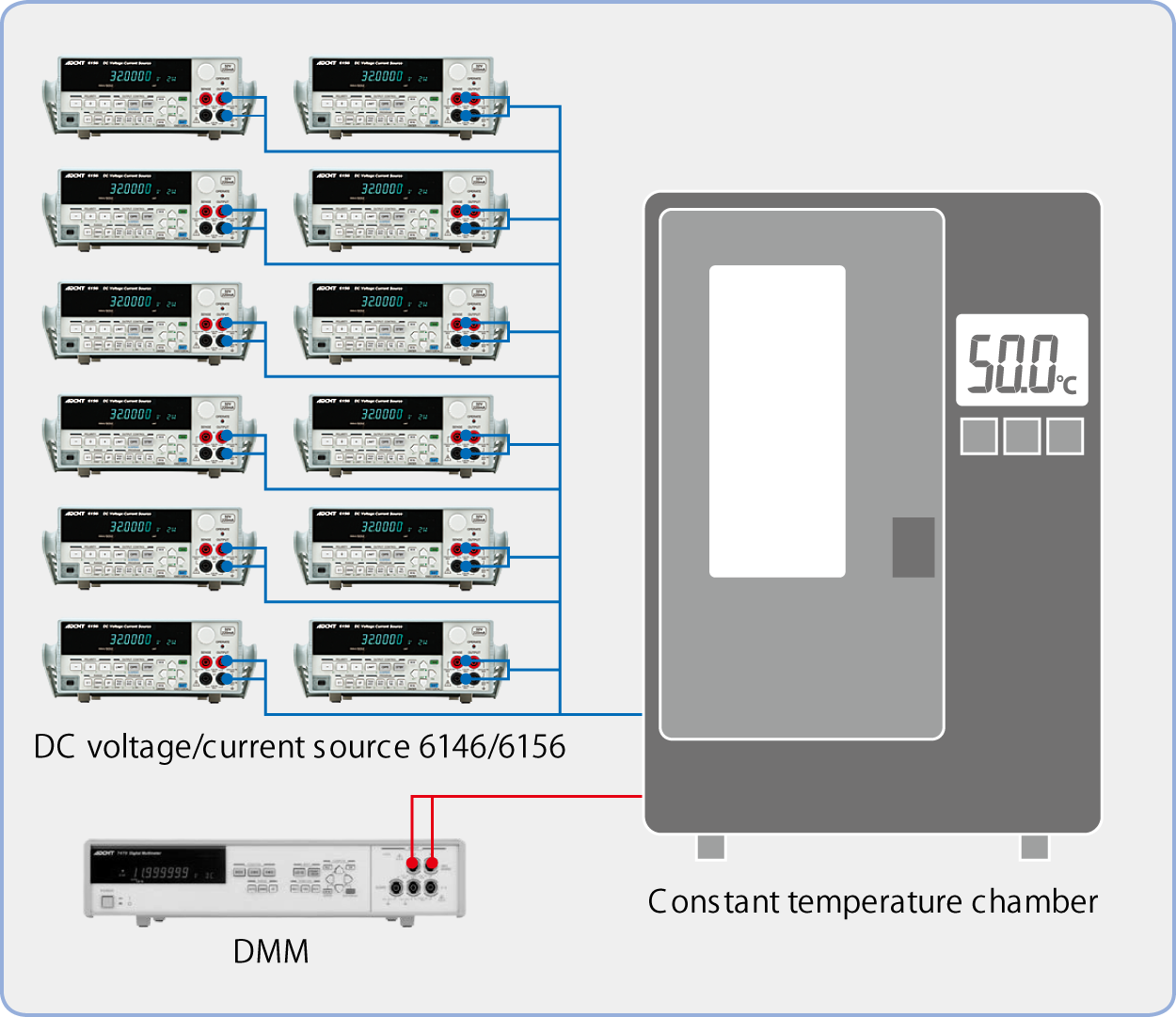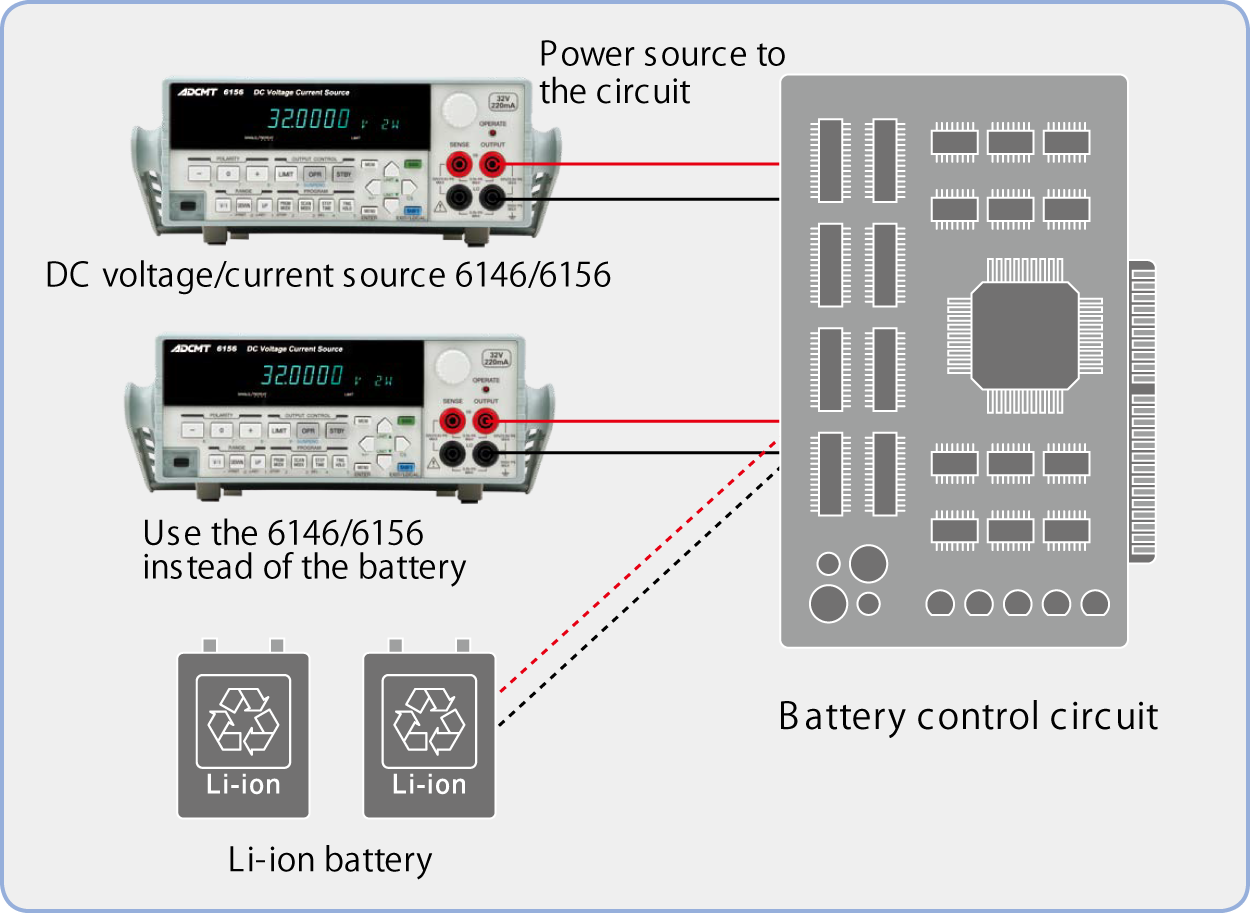
DC Voltage Current Source
6146 / 6156
- Wide dynamic range of sourcing
6146 Voltage: 0 to ±32.000 V Current: 0 to ±220.00 mA
6156 Voltage: 0 to ±32.0000 V Current: 0 to ±220.000 mA - High resolution 1 μV/100 nA (6146), 100 nV/10 nA (6156)
- High accuracy (one-year guarantee)
Basic accuracy for voltage: ±0.025 % (6146), ±0.015 % (6156)
Basic accuracy for current: ±0.03 % (6146), ±0.02 % (6156) - Synchronous operation of multiple units
- JIS-compliant thermal electromotive force output function
(6156)
The 6146/6156 is a precision DC voltage/current source suitable for characteristic evaluation of semiconductor or electronic components and modules in R&D fields and for calibration of meters or measuring instruments.
It achieves wide dynamic range, high resolution, high accuracy and low output noise based on the comprehensive DC voltage/current sourcing technologies of ADC, allowing highly reliable and high-throughput system architect.
With various user-friendly functions, the 6146/6156 can not only operate as stand-alone but also can be integrated into an auto measuring system as secondary battery simulator.
In addition, the 6156 is equipped with a thermal electromotive force output function compliant with JIS, allowing easy temperature calibration.

Features
Wide dynamic range of sourcing
The 6146/6156 adopts source or sink-enabled bipolar output within a range of ±32 V and ± 220 mA. Zero-crossing continuous variable output from negative to positive and vice versa is available.

High-speed response and low noise voltage/current sourcing

The response time in voltage or current sourcing of the 6146/6156 is greatly improved compared to the former models, and the settling time to reach the final value ±0.1 % of 10 ms or less is achieved. Consequently, the characteristic evaluation time for components or modules or the takt time for automatic test can be greatly reduced.
Also, it features low output noise of 100 μVp-p (30 V range, DC to 100 Hz band), enhancing the measurement reliability in characteristic evaluation of semiconductors or sensors.
Suspend function suitable for automatic tests
When DUTs such as electronic components or modules are replaced on automatic test equipment, the output status needs to be “Standby” that opens the output relay so as not to apply unnecessary voltage to the DUTs. Every switching between "Operate" and "Standby" turns ON or OFF the output relay, giving a great impact on the relay lifetime.
The 6146/6156 has a suspend function that keeps the output status in "high impedance (HiZ: output relay ON, high resistance)" or "low impedance (LoZ: output relay ON, low resistance)" without switching the relay. The output OFF status can be selected from these two statuses and “Standby (output relay OFF).”
Using this function can extend the relay lifetime and improve the system throughout. In addition, it can prevent transient current from being generated when connecting voltage sourcing devices such as batteries.

Multiple-unit operation and synchronous operation with DMM
In an electronic device or module test, voltage sometimes needs to be applied from more than one source. In this case, voltage to be applied to DUTs needs to vary in a synchronous timing.
More than one 6146/6156 units can be synchronized by connecting the Operate and Standby timing signals and variable voltage timing signals from the master to its slaves.
For voltage measurement using DMM, the 6146/6156 builds up an automatic measuring system with the DMM with the minimum waiting time as voltage application timing and measurement timing can be synchronized.

The 6146/6156 has a signal line for synchronous control so that multiple units can output signals in synchronization. The following shows an example of how three 6146/6156 units synchronize sweep operation using control signals. “SYNC OUT”and“OPERATE IN OUT”signals from the master are connected to“TRIGGER IN”and“OPERATE IN OUT”signals of its slaves.
HI/LO limiters separate setting
The limiter function is highly important for voltage or current sourcing to protect connected devices.
The current limiter works for voltage source to restrict output current and the voltage limiter works for current source to restrict compliance voltage. The 6146/6156 has two setting levels for both voltage and current limiters which can be set separately.

User Friendly Operation Panel

Voltage or current values to be generated can be entered directly using the keyswitches on the front panels, and can be varied (increased or decreased) continuously by specifying an arbitrary digit using the rotary knob or the UP and DOWN keys. Thus, the operability is greatly improved, so that measurement such as a device input and output characteristic test can be performed by simple key operations.
Thermal electromotive force output function (6156 only)
The 6156 is capable of generating thermal electromotive force of thermocouples in accordance with JIS standards. Selecting the type of thermocouple and temperature to be generated will output voltage corresponding to the setting temperature.
The type of thermocouple is selectable from type T, J, E, K, S, R, B and N. The reference junction compensation is at 0 ℃ or arbitrary temperature (user selectable).
This function enables temperature calibration of thermometers and other measuring instruments.
The 6156 thermal electromotive force output function can linearize the temperature and the thermal electromotive force of each thermocouple. Thus, thermometers can be calibrated easily just by setting the temperature to be calibrated on the 6156.

Applications
Reliability test of semiconductors and electronic components
To secure the reliability of electronic components such as semiconductor and sensors, aging tests with current applied are conducted on the devices. Such tests require highly stable voltage sources. In some tests, the normal operating range of the devices is verified by changing the supply voltage. With its low noise, high stability and high sourcing resolution, the 6146/6156 offers high reliability in these tests.

- The 6146/6156 is used as power source to the devices or input signal.
- A digital multimeter monitors output voltage of the devices.
- The 6146/6156 and the digital multimeter can acquire long-time aging data using GPIB or USB.
Embedded power source or signal source in a board tester
Control boards used in home electric appliance and industrial equipment undergo functional tests at shipping and incoming inspections. The 6146/6156 can be used as embedded power source in a board tester, applying voltage to a board under test and applying voltage or current as pseudo sensor signal. As the 6146/6156 stabilizes its output values with a settling time of 10 ms or less, the time of a multi-item test can be reduced. In addition, the 6146/6156 is equipped with GPIB and USB interfaces for remote control as standard, allowing highly flexible system architect.
The 6146/6156 supplies power and applies voltage as pseudo sensor signal to the board under test. The 6146 has a minute voltage resolution of 1μV and the 6156 has that of 100nV. Thus, the 6146/6156 can be used as a substitute for sensor signal and make correct PASS/ FAIL judgment on the board.

Calibration of meters and measuring instruments
Meters or measuring instruments used in plants or instrumentation systems need to be calibrated periodically. The 6146/6156 is suitable for calibration of these meters or instruments with its high source accuracy. The calibration time can be reduced by storing voltages or currents of points to be calibrated in the memory of the 6146/6156 and reading them out by turns.

Various meters including digital multimeters can be calibrated using the 6146/6156. Zero point and full scale calibrations are available by easy operation.
Characteristic test of strain sensors (strain gauges)
A strain gauge used in a strain or pressure sensor utilizes subtle variation in resistance. In a strain gauge test, resistance with a known load applied is measured using a Wheatstone bridge circuit. As a voltage source for the Wheatstone bridge circuit, the 6146/6156 is best suited with its high stability. The output voltage is measured by using a digital multimeter such as the 7461A.

Calibration of thermometers (6156 only)
When calibrating a thermometer that uses a thermocouple as a temperature sensor, DC voltage corresponding to thermal electromotive force of the thermocouple needs to be applied. The 6156 generates easily thermal electromotive force of thermocouples compliant with JIS. For reference junction compensation, the 6156 has a "room temperature compensation ON/OFF" function that generates thermal electromotive force to arbitrary temperature just by setting the source temperature and the room temperature.

- Set the temperature to be calibrated and the room temperature using the 6156 “thermal electromotive force output”function.
- The 6156 generates voltage corresponding to the setting temperature.
- Calibrate the thermometer to the setting temperature.
Evaluation test of secondary battery control circuits
As a secondary battery such as a lithium ion battery is high-energy density, the control circuit plays an important role in monitoring the charge-discharge characteristics. To test the operation of this control circuit, the 6146/6156 can be used as a battery simulator. The control circuit is tested correctly by changing the voltage of the battery simulator for each test item. The 6146/6156 realizes such precise characteristic measurement with its wide measurement range, high sourcing resolution and low output noise.

Specifications
| 6146 | 6156 | |
| Number of digits for generation | 4½ | 5½ |
| Output method | Bipolar | |
| Maximum output |
±32 V / ±220 mA |
|
| Voltage source range |
1 μV to 32.000 V |
100 nV to 32.0000 V |
| Voltage source accuracy (typical value) | 0.025 % | 0.015 % |
| Current source range |
100 nA to 220.00 mA |
10 nA to 220.000 mA |
| Current source accuracy (typical value) | 0.03 % | 0.02 % |
| Thermal electromotive force output function | N/A | Available |
| High-frequency noise (20MHz) | 3 mVp-p | |
| Settling time | 10 ms | |
| Interface | GPIB, USB, BCD (factory option) | |
| Memory | 5,000 | |
*For the detailed specifications, please download the brochure from "Download."
Optional Accessories
| Name | Part Number |
| Input cable (test probe) | A01041 |
| Input and output cable (safety plug) | A01044 |
| BNC-BNC cable (1.5 m) | A01036-1500 |
| Banana tip adapter (for A01044) | A08531 |
| Alligator clip adapter (for A01044) | A08532 |
| Panel mount set (2U half) | A02039 |
| Panel mount set (2U half twin) | A02040 |
| Rack mount set (JIS 2U half) | A02263 |
| Rack mount set (JIS 2U half twin) | A02264 |
| Rack mount set (EIA 2U half) | A02463 |
| Rack mount set (EIA 2U half twin) | A02464 |
Download
Sample programs described on the Operation Manual
*Go to the download page.













